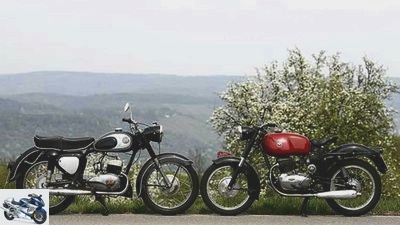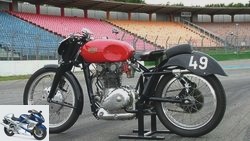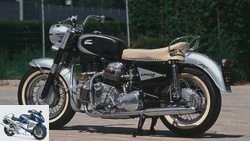Menus

Jahn
On the move: Gilera B 300, UT TS 252
Music is in the air
Content of
The air doesn’t shake, but it swings nicely: in four-stroke with the Gilera B 300, in two-stroke with the UT TS 252. The two two-cylinder engines from the 1950s invite you to compare them. Drive with us through the Swabian vineyards.
Music is in the air when the Gilera B 300 and UT TS 252 do their duet. Italian four-stroke sound and German two-stroke music make forests and corridors entertaining, motorcycles are so when driving anyway. In the background and head, the sound archive wakes up with classic songs from the 1950s and wants to do its part, just like the tube radio back then. The Gilera strongly reminds of Rudi Schuricke, the voice of Caterina Valente would go well with the subtitles.
The Gilera goes musically into the depths of the four bars, sounds heavy, strong and even. Technically most comparable to an English co-machine in small format. The UT strives for the higher two-stroke realms in terms of sound, allowing a thoroughly self-confident undertone to resonate. Something like how you imagine a two-cylinder Yamaha from the late 1960s that was plugged up for the TÜV demonstration to be on the safe side. Two two-cylinder engines are presented here for comparison, a local and a newcomer from across the Alps, a two-stroke and a four-stroke. Both are children of the 1950s and at that time represented the solid middle class of the two-wheeler market. At first glance they belong in the same world, at second glance there are worlds between them.
The Gilera B 300 was to conquer the middle class in Italy. On the one hand, she had to perform independently, on the other hand she was not allowed to stray too far from her English role models. So she got a large-capacity two-cylinder. It did without sporty frills, remained small, light, economical and affordable. The latter naturally prohibited the reinvention of the two-wheeler, but there was already the successful single-cylinder 150. Make two out of one, done, and that’s how easy it is to explain the unusual cubic capacity. The result was a smooth-surfaced block engine with a 360 degree crank pin offset, hardly recognizable as a four-stroke engine from the outside. Spur gears drive the camshaft, push rods operate the two valves hanging in parallel in the head, a duplex chain and an oil bath clutch transmit the torque to the four-speed gearbox.
The frame is also visually similar to that of the 150, but is stiffer and integrated the engine as a load-bearing element. Two-sided swing arm with struts and telescopic fork marked the state of the art in two-wheel construction. The swing saddle is a comfortable relic of its time. Series production began in the spring of 1953. Optical and technical retouching came as early as 1955: modified tank design, but above all larger brakes, such as on the test copy of MOTORRAD CLASSIC. From 1956 there was the Extra model with a double seat bench, with a tank enlarged from 15 to 19 liters and more power. A compression increased from 6 to 6.5, larger valves (plate diameter increased by 1.5 to 24 mm) and a 22 mm carburettor instead of the 20 mm one increased the power from 12.5 HP at 5800 rpm to 15 at the same speed.
Thermal problems on the engine and the electrical system accompanied the B 300. The controller moved under the tank, piston and cylinder were revised. In 1961 the cylinders, pistons and cylinder heads were completely redesigned and the crankshaft reinforced. This last version is easy to recognize by the position of the spark plugs: They are now arranged on the side. The power increased to 20 hp, unfortunately the weight by 15 kg. At the end of 1969, Gilera discontinued the B 300.

Modern Classic
On the move: Keller-Gilera dohc
Basement child
read more
Brand history, technology
Jahn
Gilera B 300.
Knowing the Gilera brand does not identify anyone as a particular motorcycle connoisseur. The question about the name UT could be found in the show "Who will be a millionaire" to settle. Gilera was available from 1909, UT from 1922. The abbreviation stood for the Stuttgart suburb of Unterturkheim. UT never built its own engines, but instead relied on engine suppliers as a manufacturer: Bekamo, JAP, Blackburne, Bark, Kuchen and Ilo, in chronological order. With Ilo and the TS 252, UT expanded its business in the 1950s, but was not just a clothing manufacturer, as there were dozens of them in Germany. UT was always more, offered technically solid, above all quality. If something didn’t work right away, the customer received improvements, usually at the highest level.
UT even put something sensational on its wheels: the TS 250, presented in 1951, was the first German motorcycle with a rear swing arm and oil-damped struts. This allowed a full 12 centimeters of spring travel at the rear, the UT-owned telescopic fork, designed by Jan Friedrich Drkosch, even shone with 14 centimeters. A chassis that is trend-setting in paper form for modern chassis construction – and it has also proven its qualities in practice.
The chassis of the TS 250 was significantly faster than its 250 single-cylinder two-stroke engine from engine manufacturer and supplier Ilo based in Pinneberg. So almost predestined for their last creation: the Ilo two-cylinder, type M2-125. UT presented the TS 252 at IFMA in 1953. The type designation suggests: Similar to Gilera, a single cylinder was the inspiration. The result was a neatly drawn, compact two-cylinder with the usual reverse flush and 1:25 mixture lubrication. A simplex chain transmitted the torque to the oil bath clutch and the four-speed gearbox.
The first engines weren’t so good, UT first had to put off the customers. Duplex instead of simplex chain, inclined jet carburetors and other pistons made the engine stable. UT replaced the Bowden cable for the rear brake with a sturdy linkage and enlarged the tank as early as 1954 – the year in which it really started; probably only a few original TS went on sale in 1953. Also in 1954, the designer improved the intake and noise damping and changed the gear ratios for 2nd and 4th gear. As with our 54 test copy.
What is noticeable at first when standing, obeys the drawer, vulgo prejudice: The Gilera looks like an Italian athlete during the training break. You immediately think of handlebar stubs, narrow mudguards, but above all a racing roll, the swing saddle disturbs the sporty line. The Italian impression continues when it is pushed: light and agile, obviously made for cornering. A short, powerful step on the non-folding kick starter makes a sound, see above.
Everything is different at UT. It is solid and heavy, nobody thinks of sporty accessories. The main stand with its two compression springs (!) Acts like a drawbridge, the motorcycle is not pushed around as easily as the Gilera. After folding the massive kick starter, a strong kick is usually enough and the two-stroke is alive. Sound: as discussed. But be careful: the two-stroke engine drowns quickly. If it doesn’t start immediately, then never again, at least via Kickstarter.
In the saddle of the Gilera you can feel a 50’s below you, the clutch requires manual power, the rocker switch for the four-speed gearbox demands force and feeling. The kickstarter disturbs the right leg, on the left it is the clutch actuation that tugs at the calf. The Italian pulls off very evenly: One can benevolently say something like this as a balanced torque curve: nothing below and nothing above. 12.5 HP is just 12.5 HP. Vibrations? Little.
You sit on top of the UT, the bench is comfortable. The clutch is normal, the gearshift is actually precise and easy. If it weren’t for the gearshift lever tailored to shoe size 59. People of normal stature have to take their feet off the rest and move them forward, so of course precision falls by the wayside. But once in motion, the UT pulls off like unleashed compared to the Gilera, the 15.1 hp suddenly feel like more. Vibrations? Barely. And in push mode the UT even dispenses with the annoying jerking of many two-stroke engines.
Driving impression
Jahn
UT TS 252.
The more powerful engine of the loyal German 250 is joined by an extremely comfortable chassis with soft rear suspension. The Gilera, on the other hand, is significantly tighter, but by no means uncomfortable, telescopic fork and struts work – somehow. You are present, nothing else. Even a few more horsepower would not overwhelm the chassis, because with its clear feedback it always gets along very well even on uneven slopes. The Italian really craves leanings in order to touch down with the boom of the main stand at an early stage.
The UT is different. It looks more cumbersome than the Gilera, with significantly more movement in the chassis. You can literally feel how telescopic forks and struts work and how the latter could use more damping. Nevertheless, a few more horsepower would not hurt here either. Slopes require more effort, the stand calls for a halt. But swinging from curve to curve with it is also great fun.
The UT brakes really well. Here someone has optimally restored the brake. Not so with Gilera: You have to pull the lever like an ox to decelerate properly. For the sake of fairness, it should be said that this could certainly be improved through nursing work, after all, Gilera was also younger and fresher.
So not everything that is red and comes from Italy has to be unconditionally sporty – see the engine of the Gilera B 300. And not everything that is black and comes from Germany has to be absolutely unsporting – see the engine of the UT TS 252.
But the Gilera never wanted to be an athlete, but a touring machine designed for comfort and running culture. The success proved this concept right: it remained in the program until 1968. The Polizia Stradale pursued their criminals, in the USA decent numbers went, which the Veglia speedometer reminds of with miles scale. Dan Blocker alias Hoss Cartwright, for example, moved a B 300. But not at the bonanza pace.
Unfortunately, the UT did not write a success story: two-cylinder two-stroke engines had to be called Adler in Germany. The company was too small and there was no way to put the skills of their motorcycles in the right light. Who knows how long Gilera drew on the myth of the four-cylinder racer alone.
Not very happy management, nothing really new after the TS, technical regression, but above all the unstoppable decline of the two-wheeler interest let UT float towards the end. A moped with sporty, Italian lines was supposed to be the turning point, a flop. In 1961 there was a UT only on order, until 1968 spare parts, then it was over.
So some sentimentality is appropriate; and what would go well with it and with the motorcycles anyway: a joint appearance by Rudi Schuricke and Catarina Valente. Rudi Schuricke brings "O mia bella Napoli" or "Home, your stars" to be heard, Catarina Valente "Where my sun shines" or "Goodbye, goodbye, Bambina". And as an encore in a duet, the Capri-Fischer: "When the red sun sinks into the sea near Capri…"

classic
CLASSIC on the move
Ducati Apollo
read more
Technical specifications
Jahn
Gilera B 300.
Gilera B 300
Engine: Air-cooled two-cylinder four-stroke engine, a camshaft below, two valves each, operated via bumpers and rocker arms, wet sump lubrication, cast iron cylinders, light metal heads and valve covers, bore 60 mm, stroke 54 mm, displacement 305 cm³, compression 6: 1, 12.5 HP at 5800 rpm, Dell’Orto round slide carburetor, type MB 20 B
Electrical system: Kick starter, battery 6 V / 7 Ah, ignition switch, Carello ignition generator
Power transmission: Multi-disc oil bath clutch, four-speed gearbox, primary drive: duplex chain, secondary drive chain
Landing gear: Tubular steel frame, open at the bottom, telescopic fork at the front, tubular steel swing arm at the rear, two spring struts, wire-spoke wheels with light alloy high-shoulder rims, front tires 3.00-18, rear 3.25-18, front simplex drum brake, Ø 185 mm, rear simplex drum brake, Ø 150 mm
Measurements and weight: Weight 142 kg, tank capacity 15 liters
Driving performance: Top speed 110 km / h
Price: 330,000 lire (1954)
Manufacturer: Gilera, Arcore, Italy

Super athlete
On the move: Honda VFR 750 R
The top of Mount Olympus
read more
Jahn
UT TS 252.
UT TS 252
Engine: Air-cooled two-cylinder two-stroke engine with reverse flushing, cast iron cylinder, separate cylinder cover made of light metal, mixed lubrication 1:25, bore 52 mm, stroke 58 mm, displacement 244 cm³, compression 6.3: 1, 15.1 HP at 6000 / min, Bing -Round slide carburetor 1/24 // 61
Electrical system: Kick starter, battery 6 V / 5 Ah, breaker ignition, Noris alternator
Power transmission: Multi-disc oil bath clutch, four-speed gearbox, primary drive: duplex chain, secondary drive: chain
Landing gear: Single-loop frame made of tubular steel, screwed rear frame, front telescopic fork, rear double-arm swing arm made of tubular steel, two suspension struts, wire-spoke wheels with steel rims, front tires 3.00-19, rear tires 3.00-19, front and rear simplex drum brakes, Ø 160 mm
Measurements and weight: Weight 155 kg, tank capacity 16 liters
Driving performance: Top speed 110 km / h
Price: 1860 mark (1955)
Manufacturer: UT motorcycle factory Schwenk & Lace K. G. Stuttgart-Mohringen
Related articles
-
Wolf On the move: Maico MD 250 WK Sporty competition for the Japanese Contents of With the MD 250 WK, Maico wanted the Japanese competition once again in 1978 …
-
On the move: the Honda VF 500 F II and Yamaha RD 500 LC
fact On the move: Honda VF 500 F II and Yamaha RD 500 LC Extreme athletes Contents from the beginning of 1984, the Honda VF 500 F II and Yamaha RD 500 LC …
-
Gilera Driving report Gilera GP 800 Grand Prix of Milan The second is already the first loser, they say. The disgrace that the king of scooters in the…
-
Wolf 14 pictures Wolf 1/14 Peugeot presented the P 105 in 1934. Wolf 2/14 Peugeot had been building motorcycles for almost 40 years, even a TT victory …
-
Driving report Gilera Fuoco 500
Driving report Gilera Fuoco 500 Fiery Elias The name given in the slogan for old steam locomotives goes well with the latest model from Gilera, the Fuoco…
-
On the move: BMW R 26 and Simson AWO 425 S.
Fisherman In comparison: BMW R 26 and Simson AWO 425 S. Same parts – BMW R 26 and Simson AWO 425 S. Content of Because they didn’t dare dream of their…
-
On the move: Benelli 254, Moto Guzzi 254, Benelli 304
wolf On the move: Benelli 254, Moto Guzzi 254, Benelli 304 Three little Italians Content of Where the lemons are blooming, the sky and the sea are azure…
-
Gilera Runner FX 125 in the test
In check: Gilera Runner FX 125 One of the best-selling scooters in Germany The Gilera Runner is not only nimble on the move, but also one of…
-
On the move with Sauerborn-Munch TTS 1200 Turbo and support BMW K 100 RS Turbo
Jacek Bilski 21 pictures Jacek Bilski 1/21 In the early 80s the Japanese thought that turbochargers would go best with small engines. Two …
-
On the move with Suzuki GT 750 and Suzuki GS 750
fact 37 pictures www.factstudio.de 1/37 With the GT 750 and GS 750, Suzuki had two attractive alternatives in its range, … www.factstudio.de 2/37 The cockpit …